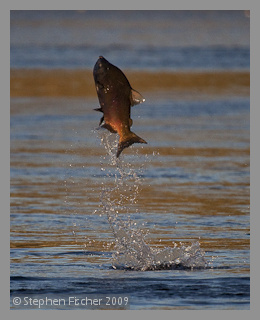 |
| Sockeye going up beaver dam. wiki Ramstad 1997 |
Here is a great podcast on hairdresser Sherri Tippie of Colorado and her story of advocacy and relocation. Ordinary citizens can make a difference, you don't have to be an officially employed biologist.
On friday was the webinar Cheap & Cheerful Stream Restoration- with Beaver?
by Joe Wheaton and hosted by the Grand Canyon Trust. Here is a link to the site where you can also listen to the webinar if you like.
I got into the webinar a little late although it was supposed to start at 2 it was already in full swing by then? Never the less it was a very informative webinar and I learned several things which I will talk about below. When reading about beaver restoration at various places I always came across this statement- "Beaver reconnect the stream with the floodplain" and I guess I misunderstood it. You see for me, growing up in arid socal adjacent to several rivers that dry up in the summer, I always thought of the floodplain as the main body of the river on sedimentary ground adjacent to the ocean. The stream feeds the river and those are in the coastal mountains prior to the floodplain. Many of our rivers become "losing rivers'" over the summer drying completely even though the more mountainous streams flow perennially. Beaver, because of their capacity to store water and replenish the water table over time, will keep water in the feeder streams and thus enhance flow to the main river ( floodplain) over the summer thus "reconnecting the floodplain to the stream" in my view. But, as I learned through the webinar, I was wrong in this interpretation although in larger strokes I am not entirely wrong in theory.
What is meant by reconnecting the river with the floodplain is best understood if you realize that the streams themselves are first of all degraded by channel incision. Many of the areas of the west are characterized by "flashy" storm systems- the proverbial flash flood- and these high velocity torrents of water erode into the stream bank, creating incised channels.
| Incised Stream Channel |
These incised streams/rivers literally gouge away all of the suitable habitat for riparian vegetation and they promote further erosion and siltage of the system. What beaver dams do is they slow the stream down, allowing it to meander horizontally and create ideal riparian zones. These dense riparian zones act as a buffer to, even during high flows, channel incision and floods. In this manner the stream reconnects to the floodplain. And in Wheaton's study he was able to quantitatively show that in beaver streams deposition outpaces erosion and so the stream is actually building up slowly over time and not carving deeper into the earth. What Joe and his team did to 'buy some time' for the beavers was put in a row of wooden posts to encourage beaver with a good framework to build dams in the spots they wanted. The incision sedimentation/depostion data and steelhead health in beaver areas was very encouraging. The human intervention- wood posts placed along stream- was fairly cheap and easy. All in all a great study and sets a precedent for how site specific beaver relocation/restoration can work in the future.
If you want to learn how costly and intensive restoration of riparian zones is please read this article New Report Identifies Restoration Opportunities in the Rose Creek Watershed (San Diego). Of course beaver would do much of the work of stream restoration for free that enhance riparian zones and mollify flood control work for human safety.
I would also like to comment that Joe always maintained a very academic, balanced tone when discussing beaver. Beaver are not always the panacea we imagine, restoration does not always go smoothly and human conflict is inevitable. His advice and the setbacks he has encountered was useful.
The question and answer segment was useful as well. I learned about the 10 km by land 50 km by ocean rule for beaver dispersal- thanks Rick. I learned that beaver may sometimes maintain "vacation homes", satellite dams and lodges that they may alternate over time. And I was also encouraged by discussion of beaver historical range into southern California. I asked a question on beaver reintroduction spreading invasives such as bullfrogs, crayfish etc etc who may use their ponds. Joe answered as well he could- "If you have an invasive problem- you have an invasive problem with or without beaver".
All in all an informative and useful webinar and I hope the study is seen and understood by many.
Cheers!!!
Support me on Patreon.
Like antediluvian salad on facebook.
Watch me on Deviantart @NashD1.Subscribe to my youtube channel Duane Nash.
My other blog antediluviansalad.blogspot


No comments:
Post a Comment